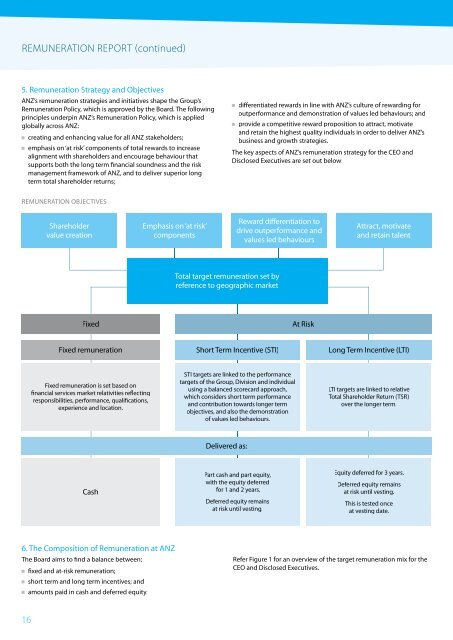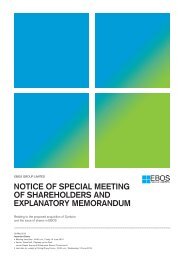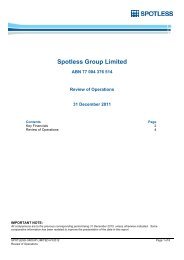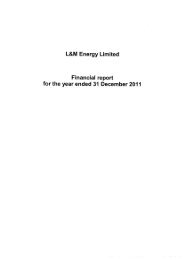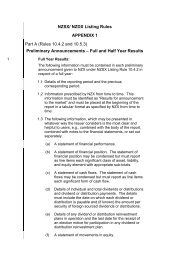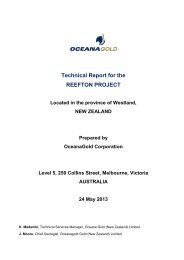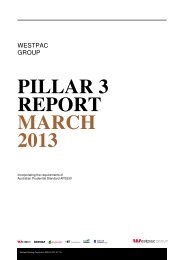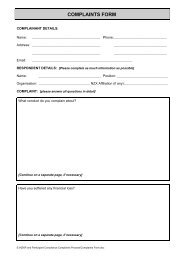2012 Annual Report - Hong Kong Monetary Authority
2012 Annual Report - Hong Kong Monetary Authority
2012 Annual Report - Hong Kong Monetary Authority
Create successful ePaper yourself
Turn your PDF publications into a flip-book with our unique Google optimized e-Paper software.
REMUNERATION REPORT (continued)<br />
5. Remuneration Strategy and Objectives<br />
ANZ’s remuneration strategies and initiatives shape the Group’s<br />
Remuneration Policy, which is approved by the Board. The following<br />
principles underpin ANZ’s Remuneration Policy, which is applied<br />
globally across ANZ:<br />
creating and enhancing value for all ANZ stakeholders;<br />
emphasis on ‘at risk’ components of total rewards to increase<br />
alignment with shareholders and encourage behaviour that<br />
supports both the long term financial soundness and the risk<br />
management framework of ANZ, and to deliver superior long<br />
term total shareholder returns;<br />
differentiated rewards in line with ANZ’s culture of rewarding for<br />
outperformance and demonstration of values led behaviours; and<br />
provide a competitive reward proposition to attract, motivate<br />
and retain the highest quality individuals in order to deliver ANZ’s<br />
business and growth strategies.<br />
The key aspects of ANZ’s remuneration strategy for the CEO and<br />
Disclosed Executives are set out below:<br />
REMUNERATION OBJECTIVES<br />
Shareholder<br />
value creation<br />
Emphasis on ‘at risk’<br />
components<br />
Reward differentiation to<br />
drive outperformance and<br />
values led behaviours<br />
Attract, motivate<br />
and retain talent<br />
Total target remuneration set by<br />
reference to geographic market<br />
Fixed<br />
At Risk<br />
Fixed remuneration<br />
Short Term Incentive (STI)<br />
Long Term Incentive (LTI)<br />
Fixed remuneration is set based on<br />
financial services market relativities reflecting<br />
responsibilities, performance, qualifications,<br />
experience and location.<br />
STI targets are linked to the performance<br />
targets of the Group, Division and individual<br />
using a balanced scorecard approach,<br />
which considers short term performance<br />
and contribution towards longer term<br />
objectives, and also the demonstration<br />
of values led behaviours.<br />
LTI targets are linked to relative<br />
Total Shareholder Return (TSR)<br />
over the longer term.<br />
Delivered as:<br />
Cash<br />
Part cash and part equity,<br />
with the equity deferred<br />
for 1 and 2 years.<br />
Deferred equity remains<br />
at risk until vesting.<br />
Equity deferred for 3 years.<br />
Deferred equity remains<br />
at risk until vesting.<br />
This is tested once<br />
at vesting date.<br />
6. The Composition of Remuneration at ANZ<br />
The Board aims to find a balance between:<br />
fixed and at-risk remuneration;<br />
short term and long term incentives; and<br />
amounts paid in cash and deferred equity.<br />
Refer Figure 1 for an overview of the target remuneration mix for the<br />
CEO and Disclosed Executives.<br />
16


